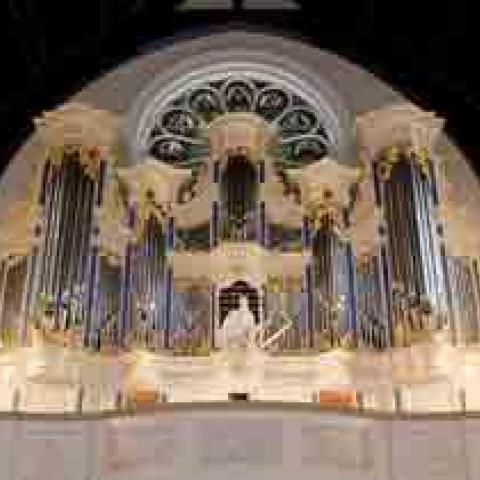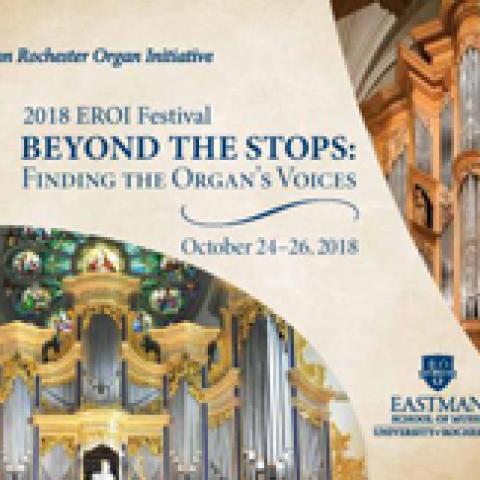The 2016 EROI Festival Breath for Singing: The Organ and the Human Voice October 26–28, 2016
Tom Mueller is assistant professor of church music and university organist at Concordia University Irvine and associate organist at St. James’ in-the-City (Episcopal) in Los Angeles, California. He was the winner of the 2014 Schoenstein Competition in Hymn-Playing and is a member of The Diapason’s ‘20 Under 30’ Class of 2015. Mueller holds degrees from the University of Maine at Augusta, the University of Notre Dame, and the Eastman School of Music.

Since its inception in 2002, the Eastman Rochester Organ Initiative (EROI) has transformed the musical landscape of Rochester, New York, and its surrounding community by assembling an extraordinary collection of new and historic organs. The EROI festivals showcase these instruments and bring together scholars, performers, and audiences to explore facets of organ history and culture. Previous conferences have focused on such diverse topics as film music, improvisation, pedal technique, the works and influence of Felix Mendelssohn, and the legacy of Anton Heiller. The 2016 conference explored a topic relevant to every organist: interaction between the organ and the human voice. Areas of emphasis included historical practice in accompaniment or alternation, modern performance practice in hymn playing, and the cognitive, psychological, and spiritual aspects of communal singing.
Wednesday, October 26
As attendees arrived for the afternoon registration session, they were greeted with a recital by Eastman faculty and students on the historic 18th-century Italian Baroque organ at the University of Rochester’s Memorial Art Gallery. Housed in the museum’s Fountain Court, this instrument is complemented by a collection of 17th- and 18th-century European artwork displayed in the surrounding galleries—a feast for both eyes and ears!
The eminent sacred music scholar Robin Leaver gave the keynote address, which addressed the balance of power between organist and congregation. Citing historical sources and musical evidence, Leaver offered an overview of the evolution of congregational singing and accompaniment across denominational traditions, regions, and eras. Leaver’s presentation and ensuing discussion, informed by his many decades of research and reflection, was warmly received by the audience.
After dinner, attendees moved to Third Presbyterian Church for a hymn festival under the leadership of organists James Bobb and Aaron David Miller, with Peter DuBois conducting a combined choir drawn from local churches. The organists offered a varied selection of hymnody, ranging from Lutheran chorales to spirituals to Latin American hymns. The service included two hymns commissioned by Eastman’s George W. Utech Congregational Hymnody Fund: Scott Perkins’s setting of Timothy Dudley-Smith’s “What Glories Wait on God’s Appointed Time,” commissioned in 2014; and the premiere of composer Nico Muhly’s setting of Thomas Troeger’s “Lord, Keep Us Modest When We Claim.” For a composer with a substantial background in church music, Muhly’s angular hymn proved surprisingly unsatisfying. If anything, it demonstrated how deceptively difficult it is to write an enduring hymn tune.
Thursday, October 27
Thursday opened with a series of papers and demonstrations. The first of these, chaired by Eastman music theory faculty Elizabeth Marvin, focused primarily on aspects of psychology, cognition, and health in the act of communal singing. A second session of lecture demonstrations brought attendees to Christ Church, home of two notable organs: 1893 Hook & Hastings Opus 1573 and the Craighead-Saunders Organ, a process reconstruction of the 1776 Casparini organ located in Vilnius, Lithuania. Under the guidance of Kerala Snyder, these presentations focused primarily on issues of historical performance practice in the sacred music of France (Robert Bates), Italy (Edoardo Bellotti), and North Germany (Frederick Gable). A highlight of this session was Bates’s paper, “Alternation Practices in France during the Classical Period,” for which Bates was assisted by University of Houston graduate student Christopher Holman. Having spent his career engaged with the music of 17th- and 18th-century France as both a performer and scholar, Bates’s authoritative presentation offered a wealth of detail as well as questions for future inquiry.
A short bus ride brought attendees to the village of Pittsford, a small outlying suburb of Rochester located on the Erie Canal, for a Singstunde—a traditional Moravian service consisting almost entirely of hymn singing. The First Presbyterian Church of Pittsford is home to 2008 Taylor & Boody Organbuilders’ Opus 57, an instrument based on the work of the early American organbuilder David Tannenberg. At the hands of Jack Mitchener, this organ proved exceptionally supportive of congregational singing. Mitchener’s masterful playing and sensitivity to both congregation and instrument was the high point of the conference. Moravian music scholar Reverend Nola Reed Knouse’s introductory lecture provided context for the service.
The final event of the day was a concert at Sacred Heart Catholic Cathedral by Eastman faculty members Nathan Laube, Edoardo Bellotti, and Stephen Kennedy, who were joined by the Christ Church Schola Cantorum under the direction of Kennedy and assistant director Thatcher Lyman. The emphasis here was chant-based repertoire, and the program included works by de
Grigny, Banchieri, Bach, Rheinberger, and Latry (among others), along with a set of versets improvised in contemporary style by Kennedy. Memorable moments of this concert included Bellotti’s rendition of Johann Sebastian Bach’s rarely performed Fuga sopra il Magnificat, BWV 733, and Laube’s assured performance of Olivier Latry’s Salve Regina.
Friday, October 28
The final day of the festival opened at Third Presbyterian Church with an unusual event: a hymn-playing masterclass. James Bobb began with a presentation on the accompaniment of multicultural hymnody at the organ, along with an overview of basic jazz harmony, idioms, and notation. He was joined by Aaron David Miller and Rick Erickson, who coached Eastman students Ben Henderson, Alex Gilson, Caroline Robinson, Chase Loomer, Oliver Brett, and Ivan Bosnar in a variety of traditional and non-traditional hymns. This was a fascinating opportunity to see both differences and similarities in the work of three master church musicians, with a wealth of concepts and ideas shared in a collegial atmosphere.
After lunch, attendees returned to Christ Church for a session of lecture-demonstration exploring the historical use of the organ as an accompaniment to congregational song. Papers by two well-established scholars (Frederick Gable and Kerala Snyder) were paired with presentations by Eastman doctoral students Jacob Fuhrman and Derek Remeš. While all four papers were outstanding, Remeš’s work to reconstruct the accompanimental practice of Johann Sebastian Bach using historical sources was particularly notable.
The festival concluded with an evening recital by Eastman organ faculty members William Porter and David Higgs at Christ Church. While the previous evening’s concert focused exclusively on the chant tradition, the program for this recital consisted of repertoire based on chorales and psalm tunes and included several congregational hymns. Highlights from this program included Higgs’s performance of Bach’s Partite diverse sopra il corale O Gott, du frommer Gott, BWV 767, accompanied by an insightful verbal program note connecting specific chorale variations with theological imagery in the chorale text; Porter’s majestic improvised prelude and postlude to the hymn, “New Songs of Celebration Render,” sung to Rendez à Dieu; and the congregational singing of the chorale Es ist das Heil to a multi-verse accompaniment composed by Johann Gottlob Werner (1777–1822) and published in his 1807 Orgelschule. The opportunity to hear Werner’s chorale setting (which includes through-composed Zwischenspiele and surprisingly variable textures and harmonic support) sung by a fully engaged audience and supported by the full resources of the Craighead-Saunders organ was a revelation, and a fitting end to the conference.



